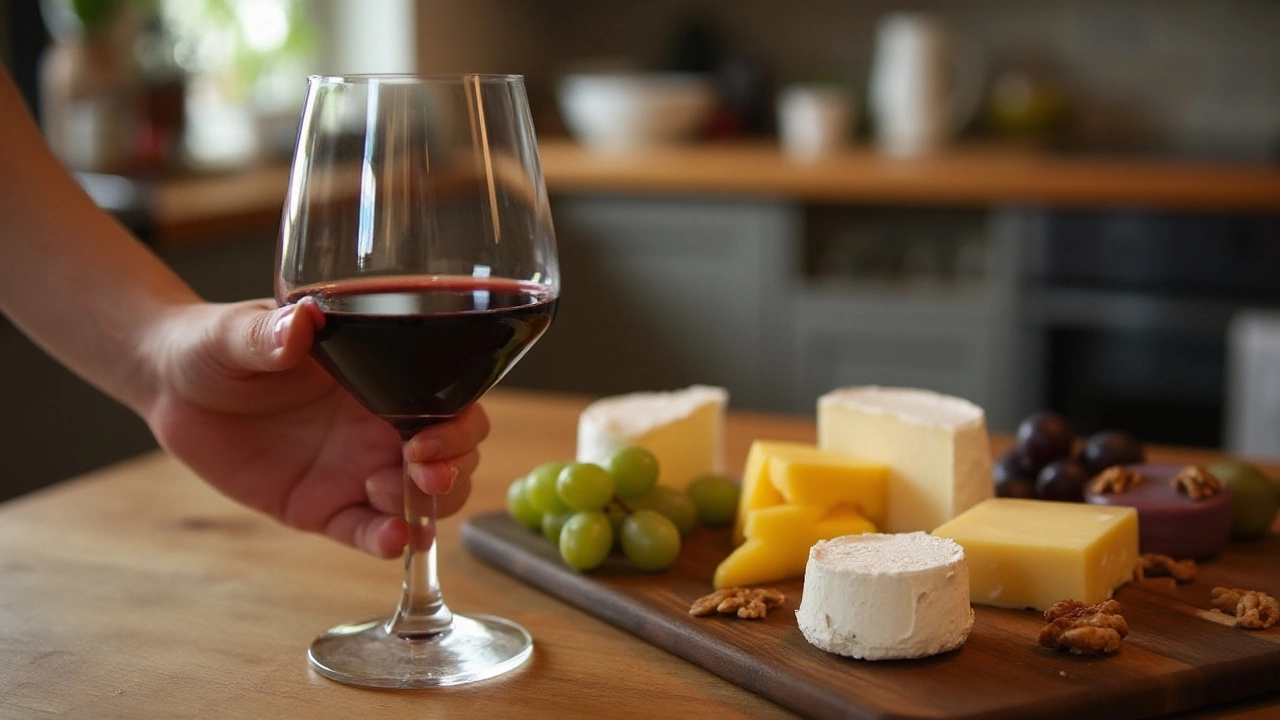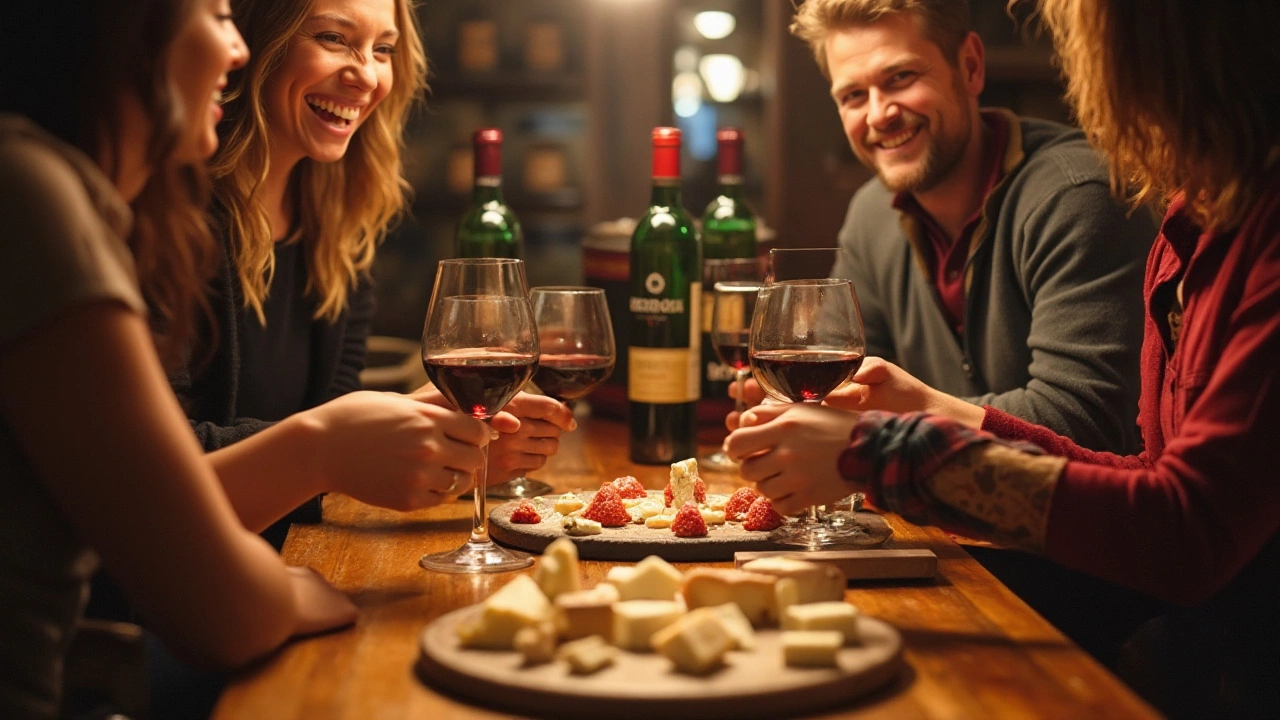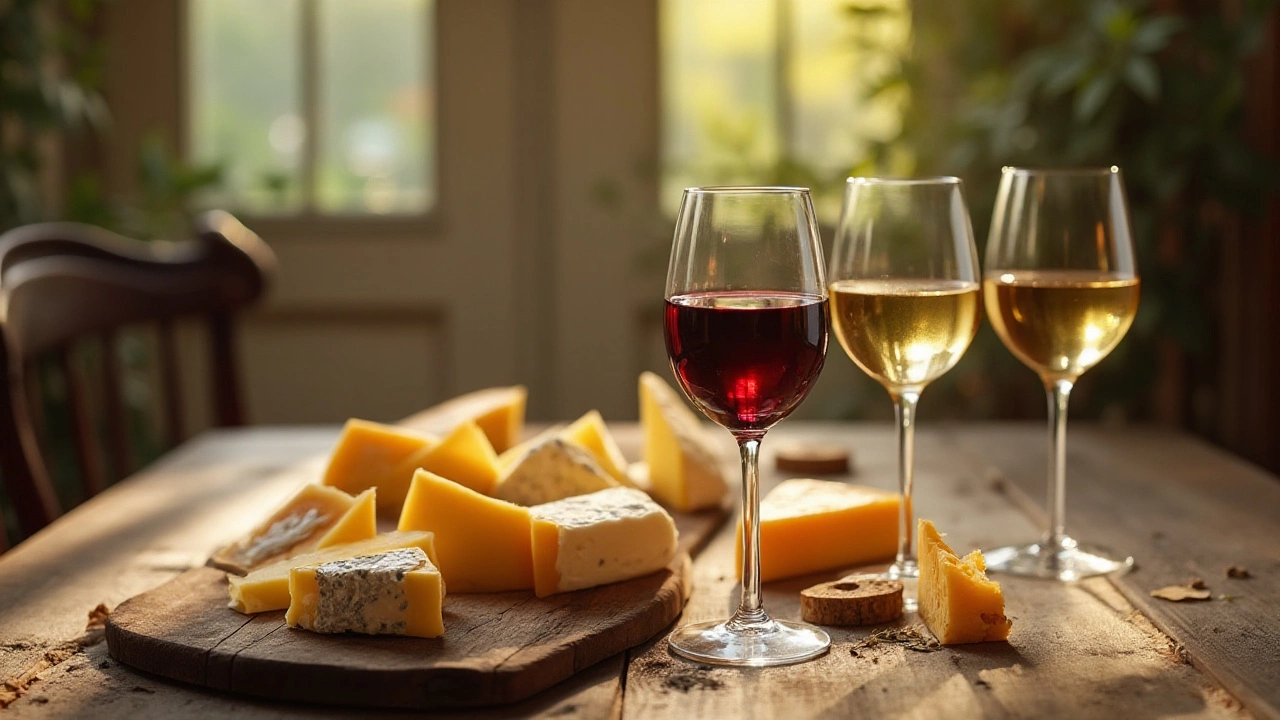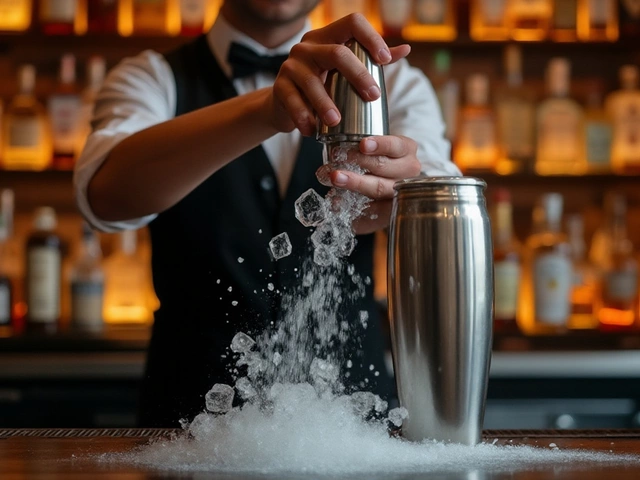In the realm of culinary matches, few duos are as iconic as wine and cheese. For centuries, they've shared the spotlight on the tables of refined gatherings and intimate dinners alike. The interaction between creamy, tangy cheese and a well-selected wine can be akin to a symphony, where each note brings out the best in the other.
Pairing these two isn't simply about pouring a glass of wine alongside a slab of cheese. There's an art to it, a balance waiting to be discovered that can transform a simple snack into a gourmet event. By understanding the different types of cheeses and wines, and how they interact with your taste buds, you can enhance your appreciation and enjoyment of them both.
- The History of Wine and Cheese Pairing
- Understanding Cheese Categories
- Choosing the Right Wine
- Tips for a Perfect Pairing
- Common Mistakes and How to Avoid Them
The History of Wine and Cheese Pairing
The tradition of pairing wine and cheese dates back several centuries, and its origins are deeply entwined with the rich tapestry of European culture. This harmonious culinary relationship has roots in the pastoral life of early European communities. As these communities developed, farmers and herders cultivated various cheeses, each with its unique set of flavors and textures borne from local terrains and climates. Concurrently, vineyards blossomed alongside fields, yielding wines that came to reflect the nuances of the same environments. Together, wine and cheese formed a symbiotic relationship, accentuating each other's distinct characteristics and enhancing gastronomical experiences.
Throughout the Middle Ages, the practice of enjoying wine and cheese became a staple across Europe. Monasteries, which were centers of learning and agriculture, played a significant role in refining these foods. Monks meticulously developed methods for producing cheese and wine that showcased the best of their regions. In France and Italy, especially, efforts were directed at ensuring both cheese and wine bore the markers of their local terroirs. These early pairings weren't just about taste but about sustaining communities, creating a sense of place and identity in a time when both were crucial.
In fact, a common phrase originating from French wine-making regions advises, "What grows together, goes together." This suggests that the wine and cheese from a particular region inherently complement each other, showcasing a union honed over time. A
quote from Julia Childbeautifully encapsulates this notion: "Wine and cheese are ageless companions, like aspirin and aches, or June and moon, or good people and noble ventures." This wisdom highlights how intrinsically linked these foods are not only through geography but also through shared culinary history.
As European colonists ventured to the New World, they brought these traditions with them, introducing wine and cheese to new audiences. In the 20th century, the globalization of food culture led to a renaissance in wine and cheese pairing. Exported cheese varieties like brie, gouda, and cheddar found new homes alongside wines from unexplored vineyards. As borders opened and products flowed across continents, the art of pairing these two delicacies became less about regional limitations and more about explorative experiences harnessing centuries of know-how. Today, wine pairing with cheese is a staple at modern dining tables, celebrations, and even casual gatherings, embodying a delightful merge of culture, geography, and history.
Understanding Cheese Categories
When it comes to cheese, the diversity is nothing short of astounding. There are over a thousand types worldwide, each with its own unique characteristics that make them distinct. This variety makes cheese a universal delight and also a bit of a challenge when pairing with the perfect wine. Cheeses can generally be divided into several categories based on factors like texture, aging process, and milk source. From fresh and soft varieties to aged and hard-bodied options, understanding these categories can enlighten your palate and guide your pairing choices.
One of the most common categories involves soft cheeses, renowned for their creamy textures and mild flavors. Brie and Camembert, known for their white, bloomy rinds, are prime examples. These cheeses pair beautifully with a light, fruity red like Pinot Noir or a crisp white wine such as Sauvignon Blanc. The wines' acidity cuts through the rich creaminess, providing a harmonious balance that highlights the flavor profiles of both elements. In contrast, hard cheeses like Parmigiano-Reggiano and Cheddar offer nuttier flavors, often with a slightly granular texture. These cheeses can stand up to a bolder, fuller-bodied red wine, such as Cabernet Sauvignon or Merlot.
Blue cheeses like Roquefort and Gorgonzola occupy a special niche, celebrated for their distinct pungency and creamy veins. These are best paired with sweeter wines, as the wine's natural sugars tame the cheese's salty bite. A classic suggestion is pairing blue cheese with a Port or Sauternes.
"Blue cheeses offer a challenging depth, blending perfectly with the sweetness and depth of fortified wines," remarks Sofie Beilharz, a seasoned sommelier at an acclaimed vineyard.Not to be overlooked are goat cheeses, whose bright, citrusy flavors and crumbly textures are well-suited to the acidic notes of a fresh Sauvignon Blanc or an herbal Chardonnay.
When selecting cheese, the milk source plays a pivotal role. Cow's milk is often creamy, sheep’s milk delivers a richer, buttery essence, and goat’s milk lends tangy and earthy notes. The aging process, too, lends distinct attributes. Young cheeses are soft and mild, while the aging process can concentrate flavors, harden textures, and introduce new aromas.
For those eager to explore something beyond the standard picks, washed-rind cheeses like Epoisses offer an adventurous medley of olfactory sensations. These strong-smelling cheeses have been bathed in brine or alcohol, contributing to their bold and sometimes complex character. A robust Alsatian Gewürztraminer can balance out these intense flavors, enhancing both the wine and cheese experiences. Embarking on this pairing journey extends beyond mere taste; it's a narrative of textures and aromas that tells the story of both the cheese-maker's craft and the winemaker’s artistry.

Choosing the Right Wine
When it comes to pairing wine with cheese, knowing your wines is just as critical as understanding your cheeses. Let's start with the basics. The foundation of a successful wine and cheese pairing lies in the ability to balance flavors and textures. A robust cheese paired with a delicate wine, for example, can overshadow the wine’s subtleties. Conversely, a mild cheese can easily be drowned out by a bold red. Think about complementing flavors rather than overshadowing each element. Famous wine blogger Gary Vaynerchuk once said, "Wine and cheese are ageless companions, like aspirin and aching heads." It's this age-old pair that requires such delicate orchestration.
When selecting wines, consider their flavor profiles. Wine pairing is more than just matching a white wine with white cheese or red wine with aged varieties. The real art lies in finding the harmony between the two. Start by identifying cheese characteristics: Is it creamy, nutty, sharp, or aged? For creamy cheeses, like Brie or Camembert, choose a wine with acidity like a Sauvignon Blanc. These wines cut through the richness and elevate the buttery notes. Hard cheeses like Cheddar find a stellar partner in Cabernet Sauvignon, which brings out cheddar's savory nuances.
Consider the origin of your selections, too. Often, cheeses and wines from the same region share complementary qualities, a practice steeped in European tradition. Pair an Italian Chianti with a wedge of Parmigiano-Reggiano, for instance, and experience a taste of Tuscany in every bite and sip. Think outside the box – a nutty Comté pairs beautifully with a slice of warm toasted bread and a glass of Chardonnay, each component bringing the crunch and creaminess to the forefront.
According to The Wine Spectator, "Cheese acts as a flavor enhancer, much like salt; it can add greater complexity and character to a wine’s taste."
Don't hesitate to experiment with multiple gourmet pairings. Often, wine and cheese tastings will feature an array of both to allow tasters to identify their own preferences and make notes. Keep a tasting journal handy when exploring new pairings. It helps to note what works and what doesn't with varying options like goat cheese with Berry-forward Beaujolais or pungent Roquefort with dessert wines.
For the data enthusiasts, below is a guide to popular cheese and wine combinations.
| Cheese Type | Recommended Wine |
|---|---|
| Brie | Sauvignon Blanc, Champagne |
| Cheddar | Cabernet Sauvignon, Zinfandel |
| Gouda | Merlot, Pinot Noir |
| Roquefort | Sauternes, Port |
| Fontina | Barolo, Chianti |
Ultimately, trust your taste buds in this exploration. Personal preference plays an enormous role in wine pairing. The perfect match for someone else might not be the one for you. Experiment with bold reds, light whites, or even sparkling wines with different cheeses. It’s not just about traditional pairings, but rather the journey of discovery and the unique pleasure these combinations bring.
Tips for a Perfect Pairing
Creating a memorable wine and cheese pairing is like painting a picture with flavors, blending tones, and textures. One principle to keep in mind is wine pairing should enhance the cheese and not overpower it. Start by matching the intensity of the wine with the cheese. For instance, a delicate brie pairs well with a light white wine, such as a Chardonnay, because its soft flavors won't drown out the wine's refreshing notes. On the other hand, a bold blue cheese demands a robust red, like a Cabernet Sauvignon, to stand up against its strong character.
Understanding the origin of both the wine and cheese can offer harmonious pairings as well. Many say what grows together, goes together. French cheeses often balance beautifully with French wines. A classic example is pairing a slice of Comté with a glass of Viognier from the Rhône Valley. The familiarity of local flavors, from soil to climate, creates an intrinsic compatibility that is hard to match with distant products. This principle is mirrored across the world, offering a treasure trove of regional pairings to explore.
"Pairing wine and cheese is a simple pleasure that can trick the mind into believing it's an art form, and perhaps, it truly is," suggested James Halliday, a well-respected authority in the wine world.
Don't shy away from experimenting with the unexpected, however. Some of the most celebrated pairings came from contrasting tastes and textures that turned out surprisingly pleasant. Soft cheeses like Camembert can go well with dry champagne, as the bubbles cut through the creamy richness, creating an elegant balance. Another interesting match can be the creamy gouda with a dash of tartness from a crisp Riesling, showcasing how cheese pairing can defy initial assumptions and still work perfectly.
Temperature plays an important role when enjoying wine and cheese together. Serve white wines chilled, but allow the cheese to reach room temperature for a fuller flavor profile. A wine that's too cold or a cheese too cold can numb the flavors, robbing the tasting experience of depth and nuance. Consider decanting red wines for larger gatherings, and let hard cheeses breathe a little before serving, just like you would with the wine.
Creating a balanced pairing is not only about flavors but can also bring a sensory pleasure that elevates the gastronomic experience. Only a few indulge without thinking about the aesthetics; how you present matters a lot. Consider carefully plated assortments, even colorful cheese boards. Think of color contrasts, using types of cheese with different shades—yellow cheddar, white goat cheese, and maybe an aged blue—to tantalize both the eyes and taste buds. At large gatherings, clearly label each cheese alongside its matching wine for guests to appreciate the thought behind the pairing.
| Cheese Type | Wine Pairing |
|---|---|
| Brie | Chardonnay |
| Blue Cheese | Cabernet Sauvignon |
| Comté | Viognier |
| Camembert | Champagne |
| Gouda | Riesling |

Common Mistakes and How to Avoid Them
The allure of wine pairing with cheese often brings both novices and seasoned enthusiasts together, sharing a mutual desire to discover harmonious matches. However, despite best intentions, many find themselves stumbling over common pitfalls in their pursuit of perfect pairings. One mistake is attempting to pair powerful wines like a robust Cabernet Sauvignon with delicate cheeses. Such pairings frequently lead to overpowering the subtle flavors of the cheese, losing the balance that a well-chosen wine should bring. Instead, matching robust wines with equally bold, aged cheeses can create a more satisfying experience.
Another frequent blunder is neglecting the importance of temperature. Serving both wine and cheese at the wrong temperatures can distort flavors. Red wines, typically served too warm, benefit from slight chilling, which enhances their original flavor profile, while white wines require chilling to maintain their refreshing quality. Cheeses, on the other hand, release their full aroma and flavors when brought to room temperature. A helpful guideline is to remove cheese from the fridge about an hour before serving and consider lightly chilling red wines if the environment is too warm.
One more common mistake relates to using a single type of wine while serving a variety of cheeses. This one-size-fits-all approach might seem convenient but often results in overshadowing the unique qualities of the cheeses. To avoid this, consider creating a varied selection of wine pairings tailored to the specific cheese types. A crisp Riesling could complement the acidity of goat cheese, while a soft Brie might shine alongside a fruit-forward Merlot. A balanced pairing enhances both the wine and cheese, creating a delightful tasting journey with each sip and bite.
"Wine and cheese are ageless companions, like aspirin and aches, or June and moon, or good people and noble ventures." - M.F.K. Fisher
Avoiding mistakes also involves being mindful of texture combinations. Mismatching texture can detract from both your tasting experience and the flavor profile of both elements. Hard, aged cheeses tend to go well with full-bodied wines, complementing each other's robust characteristics. In contrast, fresh cheeses often have delicate textures that benefit from an equally light and crisp white wine that won't dominate the cheese's subtleties. Recognizing these nuances allows for a rewarding exploration of taste.


